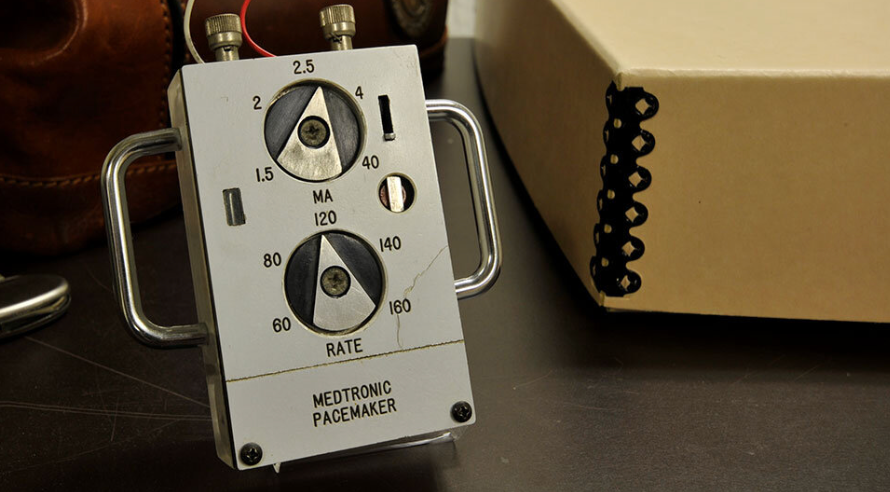
Matters of the Heart: How Medtronic’s Early Cardiac Pacemaker Helped Pave the Way to Adaptive Deep Brain Stimulation
It’s been an eventful 2025 thus far for Medtronic’s BrainSense adaptive deep brain stimulation (aDBS), and BrainSense Electrode Identifier (EI), both of which gained U.S. Food and Drug Administration (FDA) approval within the past week to treat motor symptoms in patients with Parkinson’s Disease (PD). This follows on the heels of receiving a CE Mark approval in the European Union in January. The BrainSense platform—which includes both aDBS and EI components—will now be available to over 40,000 patients in the U.S. and E.U. with PD who have a Medtronic Percept™ neurostimulator and future patients treated with one.
These regulatory approvals represent a remarkable step forward in neuromodulation.
Traditional DBS technology—called continuous DBS (cDBS)—involves constant electrical stimulation of the brain's deep areas affected in PD. This stimulation is provided by a pulse generator—usually implanted under the skin in the chest—which sends signals to electrodes implanted in the brain. This constant stimulation can alter the brain's abnormal electrical activity, improving PD symptoms—such as tremors, imbalance, or difficulty walking. But the brain’s baseline electrical activity fluctuates, and most patients with PD are on medication which also alters the brain’s electrical activity. As a result, the constant stimulation of cDBS can be too much or too little, causing fluctuations in symptom control. aDBS, as its name implies, uses brain-computer interface (BCI) technology to sense the electrical activity of the brain and can adjust the output of the pulse generator accordingly. This process is akin to modern pacemakers that can sense heart rate: When the heart rate increases, the pacemaker senses it and slows down the signals delivered to the heart, and vice versa.
In theory, this technology should result in improved, more precise motor symptom control in patients with PD.
Indeed, this theory has been born out in clinical studies thus far. The FDA and EU approvals for Medtronic’s BrainSense platform stem from the ADAPT-PD trial, a randomized, crossover, multicenter pivotal trial testing the safety and effectiveness of the BrainSense platform in patients with PD. While full results of the trial have yet to be published, early data have demonstrated the technical feasibility of the platform and improved symptom control compared to cDBS.1,2 In fact, data published in 2024 found that 98% of patients treated with both aDBS and cDBS as part of the crossover trial chose to remain on aDBS vs. cDBS after the trial.1
While we await the full results of the ADAPT-PD trial, these early data are compelling. Without a doubt, developing the BrainSense platform took ingenious theorizing, countless people-hours, brave trial participants, millions of dollars and mountains of paperwork; kudos to the study investigators and folks and Medtronic for putting in the work.
But the journey to this remarkable technology has also taken some help from another, seemingly unrelated medical field. Aristotle and many others have indicated that the heart and the mind are inextricably connected, and indeed, this is the case for the development of BrainSense.
Let’s explore a little history.
We will start in the early 20th century with Dr. Wilder Penfield, a pioneering neurosurgeon who practiced in Montreal. If you’ve taken a neuroscience course, you’re probably familiar with his most famous scientific contribution, the homunculus. Penfield discovered the homunculus by stimulating the brain's surface with electrical currents and observing the responses in awake patients. But Penfield’s use of electricity goes beyond contributing to our knowledge of neuroanatomy. In the 1930s Penfield pioneered the “Montreal Procedure” for treating epilepsy.3Similar to his mapping of the brain surface, he would apply small electrical currents to different areas of an awake patient’s brain, and by noting the patient’s response to stimulating certain regions, Penfield could “ablate”—more simply, destroy with heat—the areas thought to be involved in generating seizures.
Expanding on Penfield’s procedure, Dr. E.A. Spiegel of Temple University developed a stereotactic apparatus that, when combined with imaging, would allow surgeons to access deeper brain areas more accurately and safely.4 This apparatus's success was evident, with mortality rates for neurosurgical procedures dropping from 15% to just 1%.
Combined with the Montreal method of electrical stimulation, the stereotactic system was quickly adopted by surgeons worldwide to identify specific, “problematic” areas of the brain. By ablating certain regions of the brain, surgeons could treat a multitude of neurological ailments including psychiatric conditions, chronic pain, and movement disorders. With the number of procedures skyrocketing in the 50’s and 60’s, surgeons began to notice that the electrical stimulation used in brain mapping could briefly improve a patient’s symptoms without ablating, indicating that stimulation with electricity may be a more effective, less damaging method for treating certain diseases.
Two of the first to do this were Drs. Blaine Nashold and D. Graham Slaughter of Duke University, who noted in 1969 that stimulation of the subthalamic nucleus—the area of the brain that is now the primary target of modern DBS—could improve symptom control in patients with movement disorders.5 Resultingly, many surgeons began leaving electrodes in patients' skulls and carrying out chronic stimulation over several weeks. This meant that patients would go about their lives with wires protruding from their skulls.
In addition to being unfashionable, this rudimentary stimulation method had several problems. In between treatments, patients’ symptoms often returned. During treatments, the wires had to be connected to large, cumbersome, non-portable electrical pulse generators. As a result, neurologists and neurosurgeons quickly recognized the need for a continuous, more portable treatment method, though it wasn’t clear where this would arise.
The solution these clinicians were seeking started taking shape two decades earlier in the spring of 1949, when Earl Bakken, an electrical engineer and medical equipment repairman, co-founded a small medical device company—a company which he named Medtronic. From fixing hospital equipment at the University of Minnesota, Bakken developed a working relationship with Dr. C. Walton Lillehei, a cardiac surgeon at the University. Frustrated with the time’s inadequate, cumbersome cardiac pacemakers—which also required long extension cords and an external power source—Lillehei asked Bakken to design a novel device for his surgical patients needing external cardiac pacing. After just four weeks of experimentation and data collection in 1957—a timeframe that will never be mimicked again in our now heavily-regulated device development process—the Medtronic Cardiac Pacemaker, the first ever self-powered, wearable cardiac pacemaker, was used to treat post-surgical patients with heart block. The modern cardiac pacemaker evolved from this original device designed in a small Minneapolis garage; many medical historians opine that Bakken and Lillehei’s work spurred the modern, multi-billion dollar medical electronics industry.
Medtronic's pacemaker technology took just a decade to cross into a seemingly unrelated field: Neurology. In the late 1960s, Dr. C. Norman Shealy, a neurosurgeon in Wisconsin, began using modified Medtronic cardiac pacemakers to treat chronic pain.6 He implanted electrodes into a patient’s spinal cord connected to an implanted, modified cardiac pacemaker. The electrical signals provided by the pacemaker to the spinal cord worked to block pain signals from the spinal cord to the brain. His early results were encouraging.
After hearing of Shealy’s success with this procedure, many other neurosurgeons began applying this approach to stimulate the brains of patients with chronic pain.7 The success of these procedures was evident, and many other neurosurgeons started utilizing them to treat patients with PD.
The encouraging results reported by surgeons worldwide spurred Medtronic to expand into the neuroscience space officially. But with blossoming demand at the time, Medtronic needed another funding source to begin designing, developing, and manufacturing their neurostimulators. With the rapid success of their cardiac pacemakers—which generated roughly $100 million per annum—Medtronic was able to subsidize the development of neurostimulator devices.
And the demand kept growing.
In 1975, Medtronic made its mark in the neuro world by starting a bona fide neurological device division and officially trademarking the term “Deep brain Stimulation.” With a litany of data demonstrating greater effectiveness and fewer side effects, cDBS with implanted neurostimulators replaced ablation for the treatment of PD. In the mid-90s, they received both CE Mark and FDA approval for the treatment of PD-related tremor.
Certainly, cDBS continued incorporating advanced technology such as new imaging techniques, connectomics, improved electrodes, sleeker pulse generators, and new stimulation parameters. It has also been expanded to treat a range of additional, difficult-to-treat conditions, like depression, Alzheimer’s, and obsessive-compulsive disorder.
And now we have aDBS. Undoubtedly, recent regulatory approvals of Medtronic’s BrainSense platform for patients with PD represent another milestone for neuromodulation that can be added to the history books. I’m excited to see the final results of the ADAPT-PD trial and what other indications aDBS might be used for. Certainly, thousands of patients stand to benefit from aDBS both immediately and in the future.
What is remarkable, though, are the two ways that aDBS technology stems from the cardiac pacemaker that was born in a garage laboratory in Minneapolis: First, Bakken’s early pacemaker was adopted as the earliest neurostimulator, and second, the pacemaker's commercial success provided enough financial support to nurture the development of early Medtronic neurostimulators. It’s true, then, that aDBS is really a matter of the heart.
For a more in-depth review of the history of DBS, please read this excellent review by Dr. John Gardner. Also, please see this equally exceptional review by Dr. Oscar Aquilina.
References
1. Bronte-Stewart H, Martijn B, Ostrem J, et al. Chronic Adaptive DBS Provides Similar “On” Time with Trend of Improvement Compared to Continuous DBS in Parkinson’s Disease and 98% of Participants Chose to Remain on aDBS (S2. 008). Lippincott Williams & Wilkins Hagerstown, MD; 2024:2824.
2. Stanslaski S, Summers RL, Tonder L, et al. Sensing data and methodology from the Adaptive DBS Algorithm for Personalized Therapy in Parkinson’s Disease (ADAPT-PD) clinical trial. npj Parkinson's Disease. 2024;10(1):174.
3. Penfield W. Epilepsy and surgical therapy. Archives of Neurology & Psychiatry. 1936;36(3):449-484.
4. Spiegel EA, Wycis HT, Marks M, Lee AJ. Stereotaxic apparatus for operations on the human brain. Science. 1947;106(2754):349-350.
5. Nashold BS, Slaughter DG. Effects of stimulating or destroying the deep cerebellar regions in man. Journal of neurosurgery. 1969;31(2):172-186.
6. Shealy CN, Mortimer JT, Reswick JB. Electrical inhibition of pain by stimulation of the dorsal columns: preliminary clinical report. Anesthesia & Analgesia. 1967;46(4):489-491.
7. Hosobuchi Y, Adams JE, Rutkin B. Chronic thalamic stimulation for the control of facial anesthesia dolorosa. Archives of neurology. 1973;29(3):158-161.

Post a comment